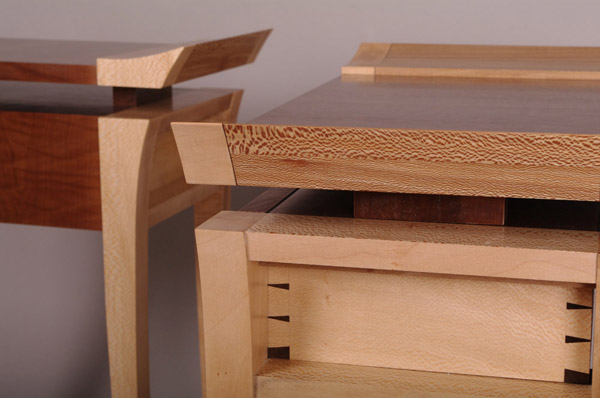Surely the woodworking world has come up with a better way of joining bits of wood together to make boxes or drawers than with those rather quaint, old-fashioned dovetails?
Well, there are finger joints, they’re pretty quick to make with a router. If you ever have anything to do with Repro furniture you’ll have come across all sorts of inventive combinations of rebates and nails, and there are mitres, but they have to be executed pretty accurately and really need a bit of reinforcement if they are to put up with any sort of abuse. They all work, at least to some degree, but are any of them as strong and good looking as a dovetail? Well I find it quite hard to argue against the dovetail as a method of jointing corners, well I would say that wouldn’t I? I spend a good deal of my time teaching people how to cut them! But their angular shape does makes the dovetail a very elegant, efficient, mechanical joint and we generally seem to find them aesthetically pleasing too.
There’s a piece of furniture at a show, it has drawers, do the people looking at the piece stand back to admire the well thought out, balanced proportions of the whole piece? No! They open a drawer and inspect the dovetails. At this point knowing glances will be exchanged, there might be a slight wince, possibly some sucking of air through teeth, or maybe a hint of a smile and an admiring nod. Rightly or wrongly, the quality of the whole piece of furniture seems to be being judged on the quality of the dovetails, which might seem to be a little harsh.
Is there actually anything to be gained from dovetail inspection? It might just reveal the fact that the maker is the proud owner of a router-based dovetailing jig, and it might not reveal that they use a band-saw to cut their dovetails because they’re rubbish at using a hand saw, all of which means that the checking of dovetails might not be a terribly reliable way of checking for quality of workmanship in a piece of furniture.
Having said that, dovetails can say something about the maker, if the tails and pins are all the same size and evenly spaced they will certainly have been machine cut and they will look pretty ugly, which might tell you that the maker doesn’t care much about the aesthetics of the piece, if he doesn’t give much thought to the joints that are visible what are the other joints going to be like? At the other end of the spectrum, there are the impossibly slim pins that can only be cut by hand, the end of the pin being just the thickness of a saw blade, if well executed this could just be construed as someone who’s showing off, and why not? This maker is saying ‘look what I can do, I’ve done hours and hours of practice working on my hand skills and I’m really good at this stuff!’ And there’s a good chance that the rest of the piece will be made to the same high standard of competence. So perhaps the folk that inspect dovetails when looking at furniture have a point.
For me, as a teacher of woodwork, a dovetail is an incredibly good way of gauging the progress of a student, it incorporates the three core skills of a cabinetmaker, planing, sawing and chiselling. There really isn’t anywhere to hide when you’re cutting dovetails (unless they’re the secret mitred variety!).
So, are dovetails still relevant after all these years………………………………?

© 2024 · John Lloyd Furniture & John Lloyd Furniture School
